My first morning in Guinea is dedicated to the “new country routine”: get local money and a local SIM card. I make sure I get the best change rate by visiting all the money changers of the market. Guinea is not part of the CFA franc zone. Yesterday, I changed a bill of 5000 CFA for 68’000 Guinean francs. One bill for a big wad of money instead. A hundred euros makes you a millionaire in Guinean francs (if you dare to carry with you 100 bills of 10’000 GNF (but probably many more as there will be 5000 and 2000 bank notes in the wad)).
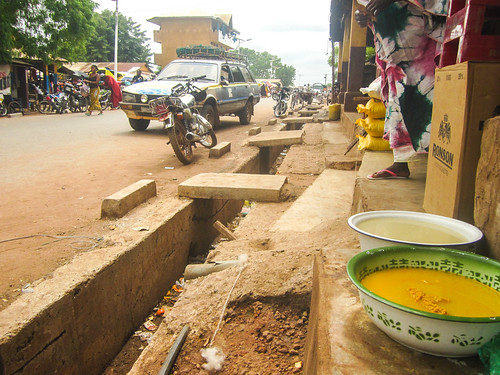
The SIM card needs registration. It is still cheap (0,50 €) but requires my ID. Before Orange and MTN took over the badly managed local network operators, the SIM cards were distributed first to the public servants, and sold if any left. Their availability went so low it created a parallel market and some paid up to 800000 GNF (80 €) to obtain one. Since a few years ago it is working much better. The rates for internet are however not very attractive. But by chance, when I tried to connect with my SIM from MTN Bissau, out of credit, it worked. It means an MTN SIM from Guinea-Bissau allows free internet roaming in Guinea on the MTN Guinea network! At last, one piece of good news about internet in Africa. That is very good luck (even if MTN has a bad coverage in Guinea and the ping of 3000ms barely lets me retrieve emails).
The route I follow takes me to the Fouta Djalon, a Guinean mountain range called the “water tower of West Africa”. The area receives heavy rains and is the source of, among others, the Gambia and the Senegal rivers, which I crossed already in the eponymous countries. The roads there are far from being good and I have been already warned (and scared) many times on cycling there during the rainy season, which is starting just now. On the other hand, I am excited to go back into beautiful mountains, which has been impossible for a long time from the Sahara until Senegal.
From Koundara, I have two options: the main road straight to Labé, the most important city of the Fouta, or a small road making a detour to Mali-ville, close to Mali (the country), not too bad but higher and longer. Unable to figure out which one is the most scenic, I pick the straight one, which should be good enough and where I should be able to find help in case it rains a lot (the Michelin map highlights it as “impassable during the rainy season”).
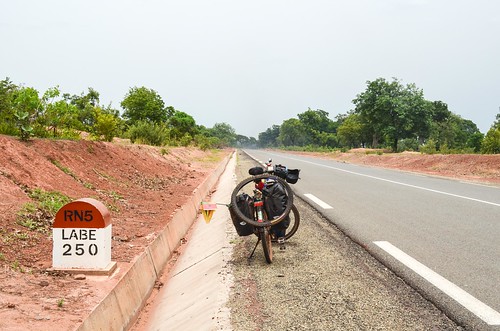
The road from Koundara to Labe is paved in the beginning. This 250 kilometer road is being built in segments by the Chinese. The first 70 km section until Boumehoun is brand new: it is very quiet and almost boring. It is rather flat, and the only distraction is to watch the big termite fields on each side of the road. They make towers up to 1 meter high, mastering an interesting architectural design.

There are much taller and more impressive termite towers, made of the red mud and up to 2 or 3 meters high, but I never found them inhabited. Those ones here looking like big mushrooms are really alive.
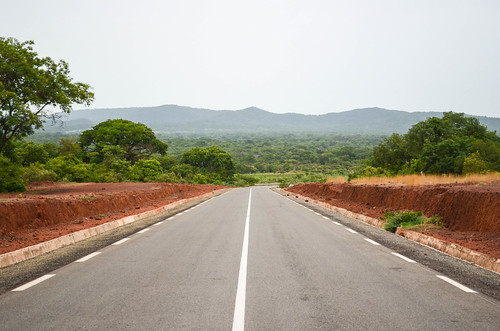
Both Google Maps and OpenStreetMap are wrong for this new road. After the heat of Senegal and Bissau, it is finally getting colder and I really enjoy this cool breeze. The locals, who call me a “Porto”, ask me quite often if the government pays me for having cycled Africa when I return home. The prejudices on European nationals are as flawed as the ones people have on European countries. There must be an explanation for each one, but I am not always able to discover it.

The sky is always grey, meaning that the rainy season is looking forward to make a show, and for the first time since Morocco I cycle over 100 m above sea level.
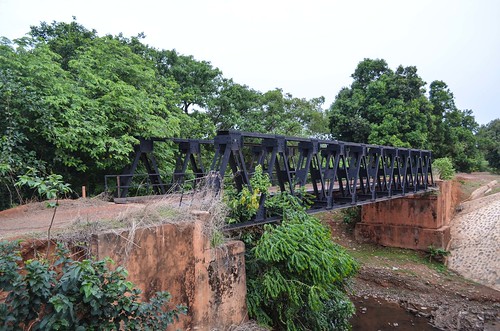
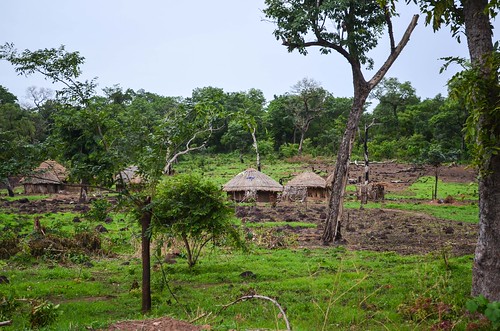
Once in Boumehoun, just before the tar disappear for a dirt track, I decide to keep the serious adventure for a new day and pitch my tent in the garden of the president of the Youth, so that I am close to a roof under which I can seek refuge in case of heavy rain. The wet atmosphere got the (bull)frogs out and their noise is almost as annoying as the roosters.
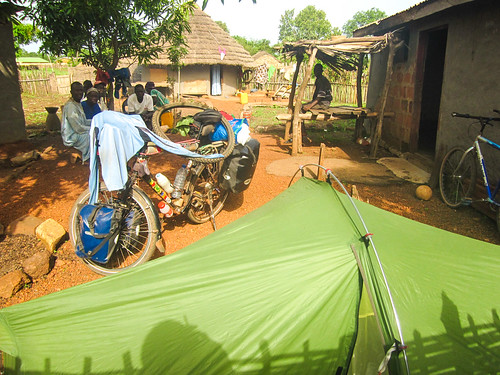

The piste from Boumehoun starts right at the end of the village and is a pleasure to cycle. Much better than the boring asphalt I had before. Instantly, the jungle is all around me; I spot monkeys and make my way through clouds of beautiful butterflies. The adventure takes place under a nice blue sky, on the red piste framed by the green lust. It is really really nice.
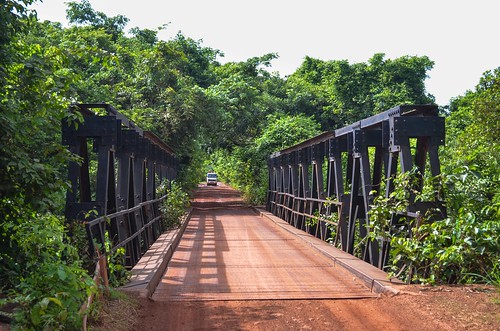

Sometimes, the narrow path makes it hard to avoid rainwater and mud pools. It reminds me that I am lucky to arrive here before heavy rains. I have been thinking about it since Dakar. And I must take advantage of this temporary dry weather to reach at least Labé, where the asphalt starts again.
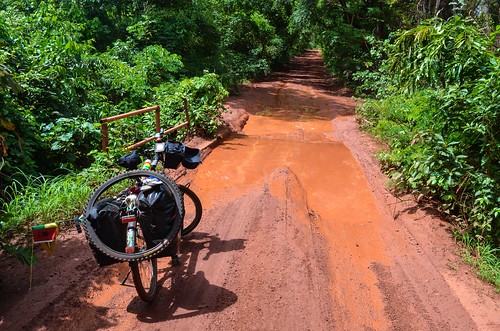
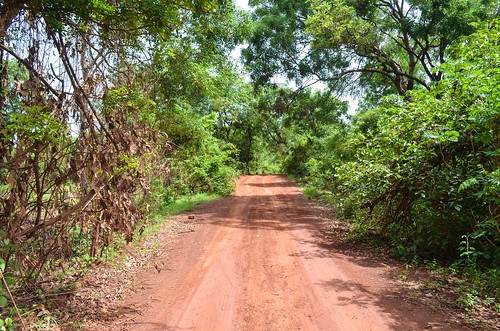
What is surprising me is that this road is the main link between Guinea and Senegal. It means that not only all passengers, but also all the trucks transporting goods are passing here. They are not numerous, but the bumpy narrow road must be a challenge for the drivers. I heard that when it comes to the hilly part, the Senegalese drivers would rather leave their seat to a Guinean.
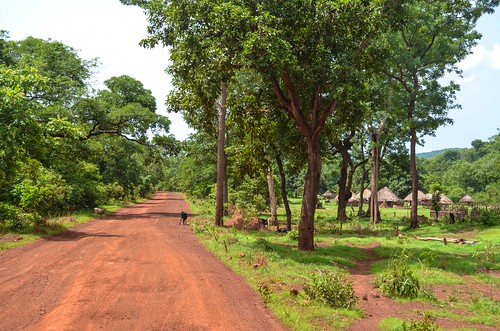

The 7-place, the Peugeot 505 collective taxi, is as popular here as in Senegal. The name of “7 passenger car” means that, besides the driver, there is 1 passenger seat in the front, 3 seats in the middle, and 3 seats in the back. Those very same cars make most of the little traffic on my road. Except that “7-seater” here is just a name: the cars are packed with as many people as it can fit, a huge amount of luggage tied on the roof, and a boy on the very top of it. Here is a bitter description of a 800 km, 2-day journey, in one of those.
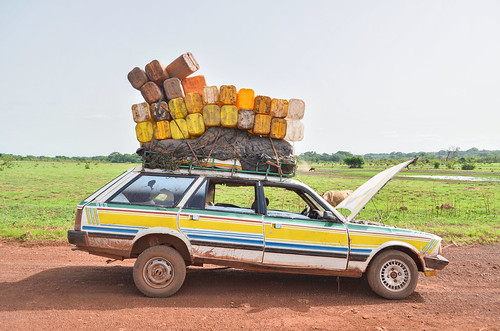
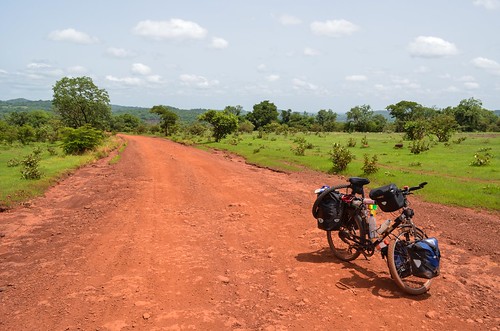
From my interaction with the Guineans, I can say that there is much less asking for money here, despite the life conditions obviously harder than their Senegalese neighbors, “begging” compulsively anytime for anything. I will never forget the “Give me your pants” or “Give me your bike” shouted from across the streets in Saint-Louis, by kids and adults with a big smile.
Little begging in Guinea, however, almost everyone wants to get out of the country. “Y’a trop de souffrance ici, il faut partir chez vous. Il faut aller là-bas“. This is the conversation starter right after the “How are you?“. I tried all kinds of answers to this daily common conversation, but I always leave with the feeling I spoke for nothing.
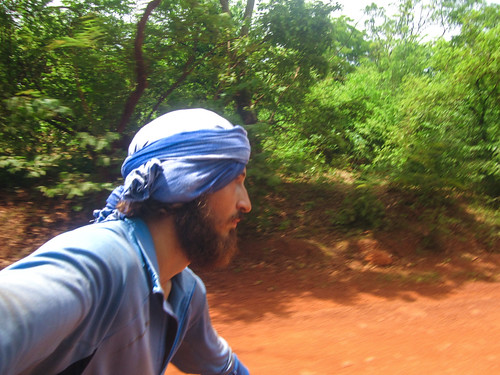
In the middle of the nowhere, the Kounsitel village has a gendarmerie checkpoint at the entrance. I am stopped and they want to see my documents. I cannot understand any word of his French, the officer is probably drunk. I am not so confident while he examines my passport, as I have heard many negative opinions about the Guinean officials. I have to explain to him, once more after the border post yesterday, the meaning of my Mauritanian visa on the first page (again, I doubt they are trained to check a passport). There is some argument ongoing among the others officers in their hut. I don’t know what to expect: at best to be released, at worst something completely illogical, and probably a demand for a small bribe anyway. Finally, the tension vanishes when he leaves my passport on his bench and asks “Are you hungry?“. This is a question that my stomach almost always answers before my brain. And almost always positively.
So he offers food and eats with me, refilling the rice under my spoon so that I can never finish the plate. The meat is good. In the middle of our strange conversation (he is definitely not sober), he starts mimicking a monkey and asks me if I have seen them on the road. I did, indeed. And he then says “this is him” while pointing at the meat in my spoon. I am surprised but after a few seconds, hmmmm, it tastes even better now I know I am eating monkey. I later learnt it is very forbidden to harm the monkeys of Guinea, but the locals of the forest do so anyway …
I give one officer (since they finally ask for something) a baseball cap in a good shape, that I had picked it up from the road a few days ago, thinking it would make a useful present at some point. He is happy and my belly is tight, life is beautiful.
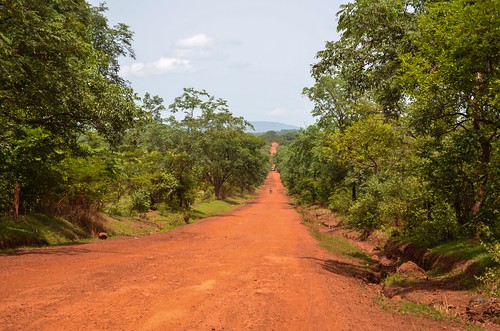
The Kounsitel village is nothing more than a traffic stop: the main road is bordered by mini restaurants and boutiques selling the same three items. Water, sardine tins and bottles of petrol. I had suspected it since Koundara, but am sure of it now: almost all of them cheat on the prices, even the prices of water and bread, that are usually the same everywhere. It was not so much happening in Senegal. Yet, I pack bread and water as if I would never find it again, like in the Sahara. This bad road is slow and there is little opportunities to buy things on the way.
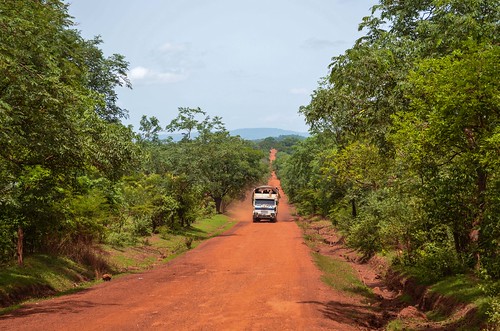
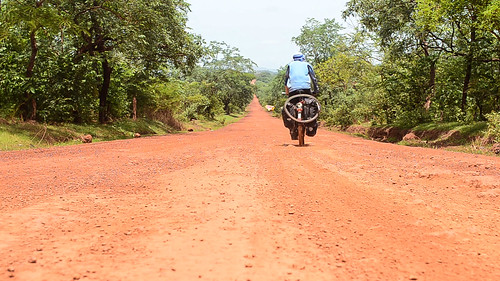
The cycling is nice and feels more like cycling hard in the “real Africa” than before. It could be pleasant if there were not all those little flies all over my face.
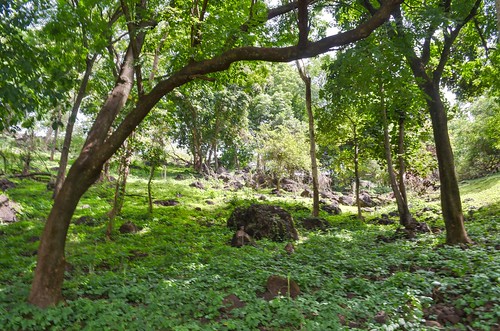
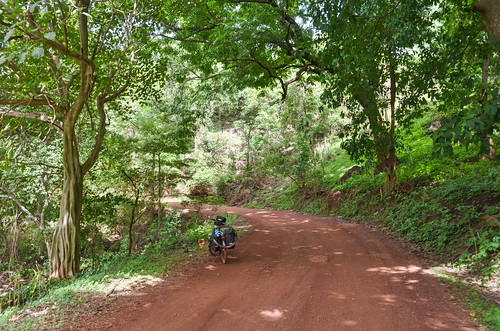

I drink the “eau de pompe”, the water from the manual pumps, without purifying it, and it doesn’t hurt me so far. I need to refill my bottles often as they don’t last long on these sweaty days. The pumps here are no more the German-made hand pumps, but French-made foot pumps. They work just as well, and the kids seem to have more fun jumping on the pedal rather than pulling a steel lever.
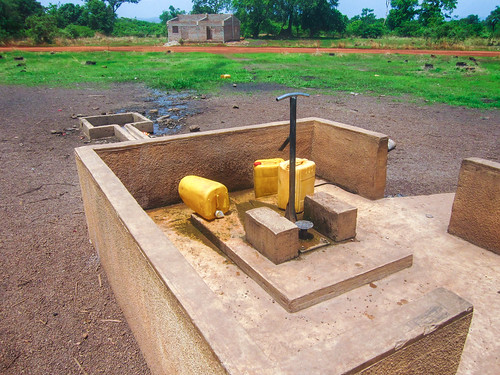

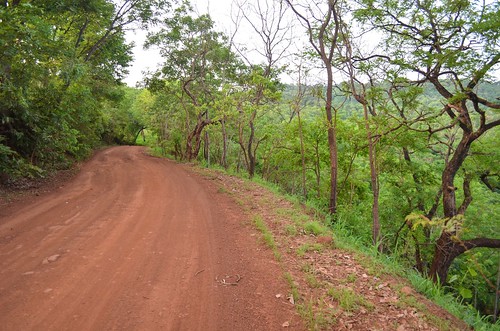
When I arrive in Bantala, the village by the Bantala river, the pump in the village is out of order. But as the one on the across the stream is said to be working, I take the ferry to cross the 50 meters of water. There is a “deviation” possible to avoid taking and paying for the “bac”, a ferry moved by two men and a crank, but it is apparently rocky and with the need to get reasonably wet. I don’t try it and go for the paid option.
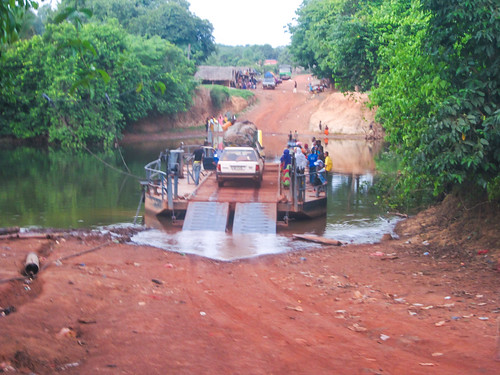
I want to camp away from the village but it is night already. So I pitch my tent with Monsieur Baldé, the former teacher in the school of the village. It is actually good to stop in a village, as I can get the pump water to bucket-shower. And we have a nice talk at night. With his experience of seeing the kids growing up, I get to know another side of the “we need to go to Europe” story that I head repeatedly. He worked 40 years for the state and lives in a modest house with a small pension (which is already a privilege). On the other hand, he saw some of his students, grown up, returning after a couple of years in Europe with 4×4 cars. They are now building big houses in Conakry, with the money quickly made from selling drugs in Switzerland and Norway. The obvious gap between those two lives make hard work and education look useless. Only one of these “success story” examples in the region is enough to sell dreams to all the young people. In turn, every time I am approached by those young, clueless people, they can convince me Europe is a paradise and it will save their lives.






Hey I saw your pictures on Flickr so came here. I’ve done two beekeeping projects in Guinea so it was really fun to see your pictures and posts. I think you may have more blog posts on Guinea I’ll look for them and then maybe the rest of your trip. What an adventure!
Bonjour Monsieur
Tu as bien été à fouta djalon mais tu laisser quelques colis qu’on a pas aimer que tu laisse ici avec notre image (la photo que tu as pris nue ) c’est quelques choses qui ne va pas avec notre culture,nos moeurs
S’il te plaît retire cette image
Bonjour
Passez nous voir sur la N-1 qui coupe l’Algerie en 2 à Hassi Bahbah et Djelfa 300Km sud d’Alger les 505 taxi ne manquent pas ! 😉